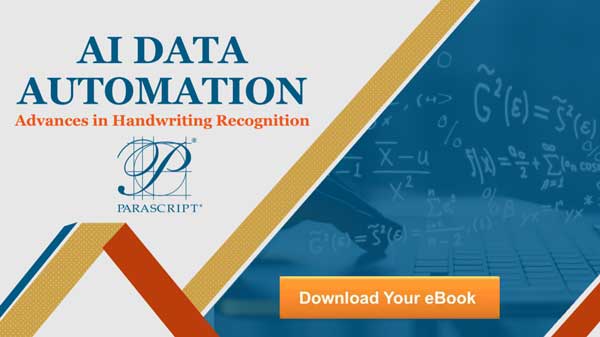One roadblock on the journey to going paperless — which is often overlooked — is handwritten information. Traditional data capture systems work primarily with printed data and not so well with handwritten information. Elements like written comments, annotations and signatures fall mostly outside the scope of common capture scenarios as a result.
“Data Capture” is a familiar capability that allows us to capture and digitize information that would otherwise be locked on paper. It is a common practice to scan a physical page and automatically extract bits of printed information from the page. This approach is a cornerstone to digital transformation; it removes the burden of paper, digitizes and uses information in more agile and intelligent ways.
According to the recent “Leaders in Capture Survey” co-sponsored with AIIM International, nearly 30% of the organizations surveyed indicate that the inability to extract handwritten data on documents is the number one weakness of their data capture system. The inability to handle unstructured documents like correspondence, contracts or service logs was a top drawback for 23% of organizations.
Nearly 30% of the organizations surveyed indicate that the inability to extract handwritten data on documents is the number one weakness of their data capture system.
This tells us that most organizations are failing to cash in on the full value of advanced capture technologies like FormXtra.AI from Parascript that now include the ability to capture handwritten and unstructured data.
If you thought that it was impossible to get a handle on handwritten data, now is the time to take a fresh look at the capabilities for new advantages and benefits. Here are three reasons why:
#1 – Gain Full ROI from Capture Investments
While 100% of the organizations participating in the study earlier this year had data capture systems already in place, only half employ any kind of handwritten text recognition technology. Most have inbound forms that contain handwritten data fields, yet very few are attempting to capture this information, either deferring it to manual keying or ignoring it outright. The result is that organizations are not getting full return on their investment by overlooking handwriting in the mix. This trend may be changing, however, as more and more organizations are coming to recognize that handwriting and annotations can play an important role in their digital transformation strategies.
#2 – Access Overlooked Content
More and more organizations today are looking for ways to leverage overlooked content – which, among other things, includes handwritten information that exists on forms, contracts and documents but is disregarded in the data capture process. Despite increasing digitization, a great number of business forms still contain handwritten entries – replies, notes and signatures – that are vitally important, especially when you begin to look at this data from a digital transformation point of view. Legal discovery, privacy, compliance, process improvement, archival and retention, and a host of other aspects and applications all point to the importance of overshadowed and overlooked handwritten content.
#3 Leverage “Intelligent” ICR
Most of us are familiar with OCR, or Optical Character Recognition, which is the ability to recognize and capture data that is machine-printed on a page. But what about handwriting? Intelligent Character Recognition, or ICR, is an advanced character recognition technology that allows handwritten data to be digitally captured during the scanning process. This gives organizations wide ability to capture, understand and manage handwritten content that would otherwise be lost or that is generally not used in intelligent ways. In financial services, it could mean checking for completeness of new account forms and for signatures on compliance statements. In healthcare, it might mean finding and redacting handwritten data for HIPPA privacy compliance. For a utility or telecom company, it often means the ability to collect and analyze handwritten log comments and include that information for use in data analytics.
Moving Forward
If you have not considered handwriting as part of the data capture mix, it’s time to reconsider the possibilities. Organizations can no longer afford to ignore valuable handwritten content, especially as demands for information agility increase. Handwritten data and free-format fields play an important role in most business processes – and an increasing one as organizations seek to exploit the value and advantage they may contain.
If you have not considered handwriting as part of the data capture mix, it’s time to reconsider the possibilities.
As a result, ICR and handwriting can and should be a viable and important part of your digital transformation strategy. Look for solutions and partners that provide you with the right mix of experience, vision and advanced capabilities that will illuminate the way to discover the full value of the technology.
# # #
Kevin Craine is the author of the book Designing a Document Strategy and host of the Document Strategy Podcast. He is the managing director of Craine Communications Group. For more information visit CraineGroup.com. Author’s note: All thoughts and opinions expressed here are my own and not influenced by the developing company or its affiliates.
If you found this article interesting, you might also find this eBook useful, AI Data Automation: Advances in Handwriting Recognition.





